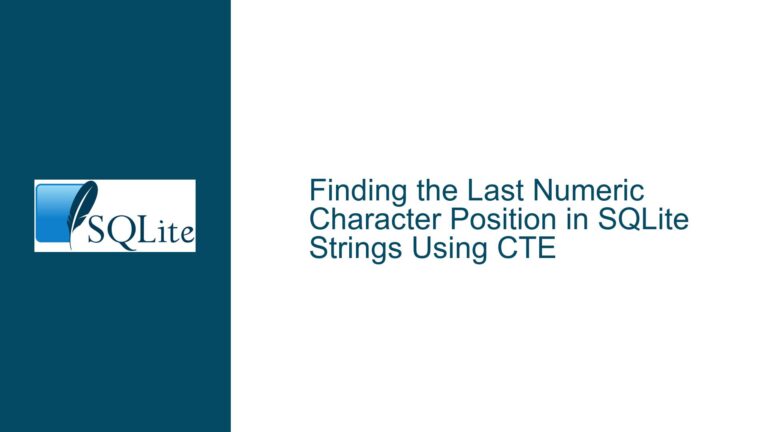Infinite Loop in SQLite Due to Crafted WITH Recursive Statement
Infinite Loop in SQLite Opcode Execution Caused by Recursive WITH Clause
The issue at hand involves an infinite loop occurring during the execution of a specific SQLite query that utilizes a recursive WITH clause. The query in question is designed to recursively select data from a Common Table Expression (CTE) without a proper termination condition. This results in the SQLite virtual machine (VM) entering an infinite loop during opcode execution, specifically between the OP_Rewind and OP_Goto instructions. The loop is triggered by the recursive nature of the query, which continuously generates new rows without ever reaching a stopping point. This behavior can lead to a denial of service (DoS) condition in applications that rely on SQLite for database operations.
The query causing the issue is as follows:
WITH a AS (
SELECT 1 WHERE 1
UNION ALL
SELECT * FROM a
)
SELECT 1 IN a ORDER BY 1 LIMIT 1;
This query defines a CTE named a that recursively selects the value 1 and unions it with all rows from itself (SELECT * FROM a). The lack of a termination condition in the recursive CTE causes the query to generate an infinite sequence of rows, which in turn causes the SQLite VM to enter an infinite loop during execution.
The opcode trace reveals that the loop occurs between addresses 15 (OP_Rewind) and 25 (OP_Goto). The OP_Rewind instruction is used to reset a cursor to the beginning of a table or index, while OP_Goto is used to jump to a specific address in the opcode sequence. In this case, the OP_Goto instruction at address 25 jumps back to address 15, creating an endless cycle.
Recursive CTE Without Termination Condition Leading to Opcode Loop
The root cause of the infinite loop is the absence of a termination condition in the recursive CTE. In SQLite, recursive CTEs are designed to allow queries to reference themselves, enabling the execution of recursive algorithms directly within SQL. However, recursive CTEs must include a termination condition to prevent infinite recursion. In the case of the problematic query, the CTE a recursively selects from itself without any condition to stop the recursion.
The opcode sequence generated by SQLite for this query includes a loop between OP_Rewind and OP_Goto. The OP_Rewind instruction is used to reset the cursor to the beginning of the result set, while OP_Goto is used to jump back to the start of the loop. Because the recursive CTE continuously generates new rows, the loop never terminates, causing the SQLite VM to enter an infinite loop.
The opcode trace shows the following sequence of instructions:
15: OP_Rewind // first loop starts
...
25: OP_Goto // first loop ends
15: OP_Rewind // second loop starts
...
25: OP_Goto // second loop ends
...
This sequence repeats indefinitely, as the recursive CTE continues to generate new rows without ever reaching a stopping point. The lack of a termination condition in the recursive CTE is the primary cause of the infinite loop.
Mitigating Infinite Loops in Recursive CTEs with Proper Termination Conditions
To resolve the issue of infinite loops in recursive CTEs, it is essential to ensure that all recursive queries include a proper termination condition. In SQLite, recursive CTEs should be designed with a base case that stops the recursion when a specific condition is met. Without a base case, the recursive CTE will continue to generate new rows indefinitely, leading to an infinite loop in the SQLite VM.
Implementing a Termination Condition in Recursive CTEs
The following example demonstrates how to modify the problematic query to include a termination condition:
WITH RECURSIVE a AS (
SELECT 1 AS value, 1 AS depth
UNION ALL
SELECT value + 1, depth + 1 FROM a WHERE depth < 10
)
SELECT * FROM a;
In this modified query, the recursive CTE a includes a termination condition (WHERE depth < 10) that stops the recursion after 10 iterations. The depth column is used to track the number of recursive iterations, and the recursion stops when depth reaches 10. This ensures that the query does not enter an infinite loop.
Using LIMIT to Control Recursion Depth
Another approach to preventing infinite loops in recursive CTEs is to use the LIMIT clause to control the maximum number of rows generated by the query. The LIMIT clause can be used to restrict the number of rows returned by the recursive CTE, effectively limiting the depth of recursion.
WITH RECURSIVE a AS (
SELECT 1 AS value
UNION ALL
SELECT value + 1 FROM a
)
SELECT * FROM a LIMIT 10;
In this example, the LIMIT 10 clause ensures that the query returns no more than 10 rows, regardless of the depth of recursion. This approach can be useful in scenarios where the termination condition is not easily expressed in the recursive CTE itself.
Detecting and Preventing Infinite Loops in Application Code
In addition to modifying the recursive CTE, it is important to implement safeguards in the application code to detect and prevent infinite loops. One approach is to set a timeout for SQLite queries, ensuring that any query that takes too long to execute is automatically terminated. This can be achieved using the sqlite3_progress_handler function, which allows the application to monitor the progress of a query and abort it if necessary.
#include <sqlite3.h>
#include <stdio.h>
int progress_handler(void *data) {
static int count = 0;
count++;
if (count > 1000) {
printf("Query aborted due to excessive recursion.\n");
return 1; // Abort the query
}
return 0; // Continue the query
}
int main() {
sqlite3 *db;
sqlite3_open(":memory:", &db);
sqlite3_progress_handler(db, 100, progress_handler, NULL);
const char *sql = "WITH RECURSIVE a AS (SELECT 1 UNION ALL SELECT * FROM a) SELECT * FROM a;";
sqlite3_exec(db, sql, NULL, NULL, NULL);
sqlite3_close(db);
return 0;
}
In this example, the progress_handler function is called every 100 VM instructions. If the handler is called more than 1000 times, the query is aborted to prevent an infinite loop. This approach provides an additional layer of protection against infinite loops in recursive CTEs.
Analyzing Opcode Execution to Identify Infinite Loops
For advanced debugging, it is possible to analyze the opcode execution trace to identify potential infinite loops. The opcode trace provided in the original issue shows the sequence of instructions executed by the SQLite VM, including the loop between OP_Rewind and OP_Goto. By examining the opcode trace, developers can identify the specific instructions that are causing the loop and take steps to modify the query or the underlying schema to prevent the issue.
The following table summarizes the key opcodes involved in the infinite loop:
| Address | Opcode | Description |
|---|---|---|
| 15 | OP_Rewind | Reset the cursor to the beginning of the result set. |
| 16 | OP_NullRow | Set the row pointer to NULL. |
| 17 | OP_RowData | Copy the data from the current row to a register. |
| 18 | OP_Delete | Delete the current row from the table. |
| 19 | OP_Column | Extract a column value from the current row. |
| 20 | OP_Yield | Yield control to the caller, allowing the query to be interrupted. |
| 21 | OP_Column | Extract a column value from the current row. |
| 22 | OP_MakeRecord | Create a new record from the current row values. |
| 23 | OP_NewRowid | Generate a new row ID for the current row. |
| 24 | OP_Insert | Insert the new record into the table. |
| 25 | OP_Goto | Jump back to address 15, creating an infinite loop. |
By understanding the role of each opcode in the loop, developers can identify potential modifications to the query or schema that could prevent the infinite loop. For example, adding a termination condition to the recursive CTE or limiting the number of rows generated by the query can help avoid the issue.
Conclusion
Infinite loops in SQLite caused by recursive CTEs without termination conditions can lead to denial of service conditions in applications. To prevent this issue, it is essential to ensure that all recursive CTEs include a proper termination condition or use the LIMIT clause to control the depth of recursion. Additionally, implementing safeguards in the application code, such as query timeouts and progress handlers, can help detect and prevent infinite loops. By analyzing the opcode execution trace, developers can gain deeper insights into the root cause of the issue and take appropriate steps to resolve it.






